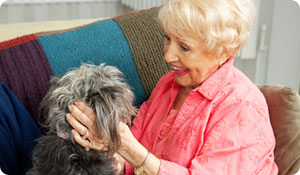
Here are five common household items that seem harmless, but could be very dangerous if ingested by a dog or a cat:
1. Yard Treatments: While cocoa mulch can be good for your lawn, this sweet smelling item, made from cocoa bean shells, can be toxic to animals. Other forms of lawn fertilizers and treatments can also contain ingredients that can be hazardous to pets. Select pet-friendly options or go without these yard treatments. If you must fertilize your lawn with dangerous ingredients and/or chemicals, keep your pets away at least until a few days after you get a good rainstorm to wash the remains away. If there's no rain in the forecast, water your lawn heavily several times.
2. Medications: Thee pain relievers, cold medicines, and vitamins that make you feel better can actually make your animals very sick. That's why you should store all prescription and over-the-counter remedies in your medicine cabinet or on a high shelf well out of reach of your animals. Remember that childproof containers won't be enough to stop animals from chewing through the bottles and getting at these toxins. Even pet medicines can pose a threat to your four-legged friends if taken in excess, so be sure to also keep them somewhere safe.
3. Plants: Many plants are beautiful to look at, but did you know that some of them could also be poisonous to pets? Some of the most dangerous varieties include crab apples (which contain cyanide), lilies (a serious cat toxin that can cause kidney failure), azalea (this can affect the heart and nerves), and certain types of ivy (which can lead to intestinal distress). Many other types of plants can also be deadly to your pets, so if in doubt about what's safe to keep, always check with your vet.
4. Chocolate: Chocolate may top your list of favorite treats, but it's also one of the most harmful foods for dogs and cats to eat. The problem lies in the high stimulant properties it contains. If your dog or cat eats enough of it, it can lead to a range of serious effects including gastrointestinal symptoms, heart irregularity, seizures, liver failure, and death. The high fat content in chocolate can also damage your pet's pancreas. These facts should cause you to be vigilant about keeping chocolate away from your pets.
5. Sugar-Free Gum and Candy: Gum and candy made with a sugar substitute called xylitol can prove deadly to dogs. This substance can cause the animal's blood sugar to dramatically plunge, and without emergency treatment, many dogs who ingest this won't be able to survive. Some cough drops and vitamins can also contain xylitol, so read labels and be sure to keep these items somewhere completely unobtainable for your dogs.
What to Do in an Emergency
If all of your precautions fail and you believe that your pet has eaten one of these toxic household items, or anything else that could be hazardous to his health, contact an emergency veterinary service immediately. Signs of poisoning include listlessness, abdominal pain, vomiting, diarrhea, muscle tremors, lack of coordination, and fever. For a fee, you can also contact the ASPCA Animal Poison Control Center's hotline at (888) 426-4435 any time—day or night.
Sources:
ASPCA. "Top 10 Pet Toxins of 2011." 2011. Web. 28 May 2012.
http://www.aspca.org/pet-care/poison-control/top-10-pet-poisons-of-the-year.aspx
ASPCA. "Animal Poison Control FAQ." N.D. Web. 28 May 2012.
http://www.aspca.org/pet-care/poison-control/animal-poison-control-faq.aspx
ASPCA Blog. "Pet Poison Alert: Cocoa Bean Mulch Can Be Poisonous for Dogs." 10 May 2010. Web. 31 May 2012.
http://www.aspca.org/Blog/pet-poison-alert-cocoa-bean.aspx
The Humane Society of the United States. "Common Household Dangers for Pets." 9 Nov. 2009. Web. 28 May 2012.
http://www.humanesociety.org/animals/resources/tips/common_household_dangers_pets.html





